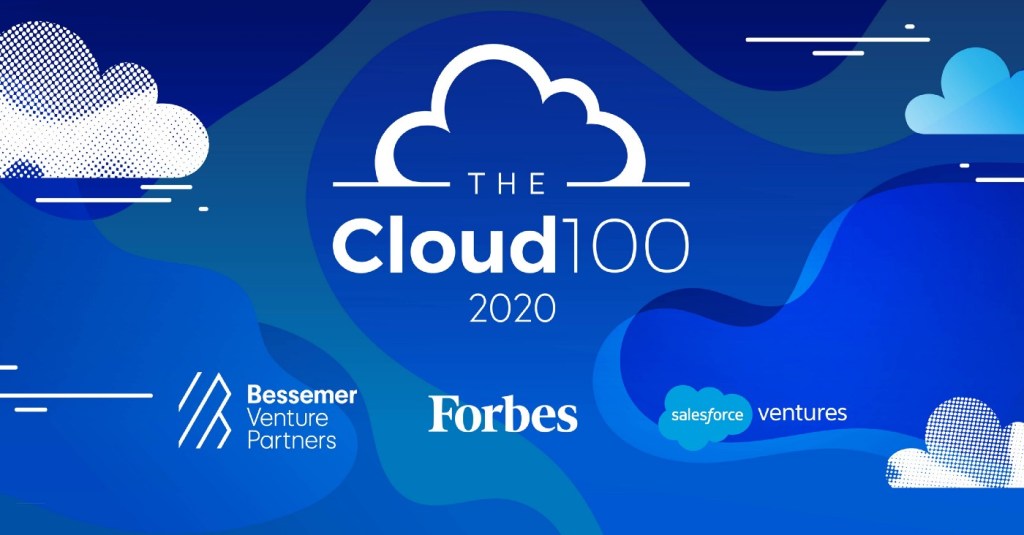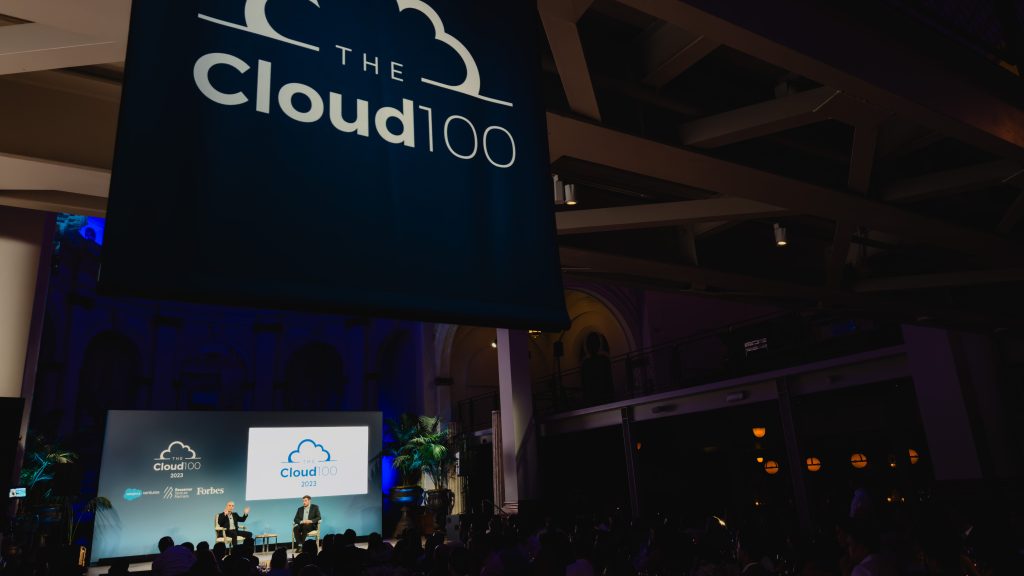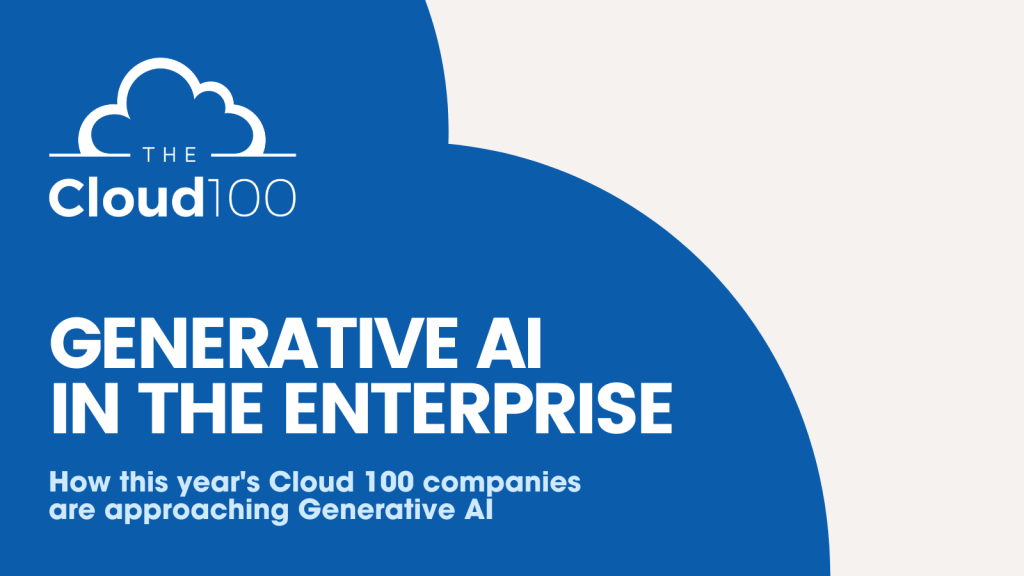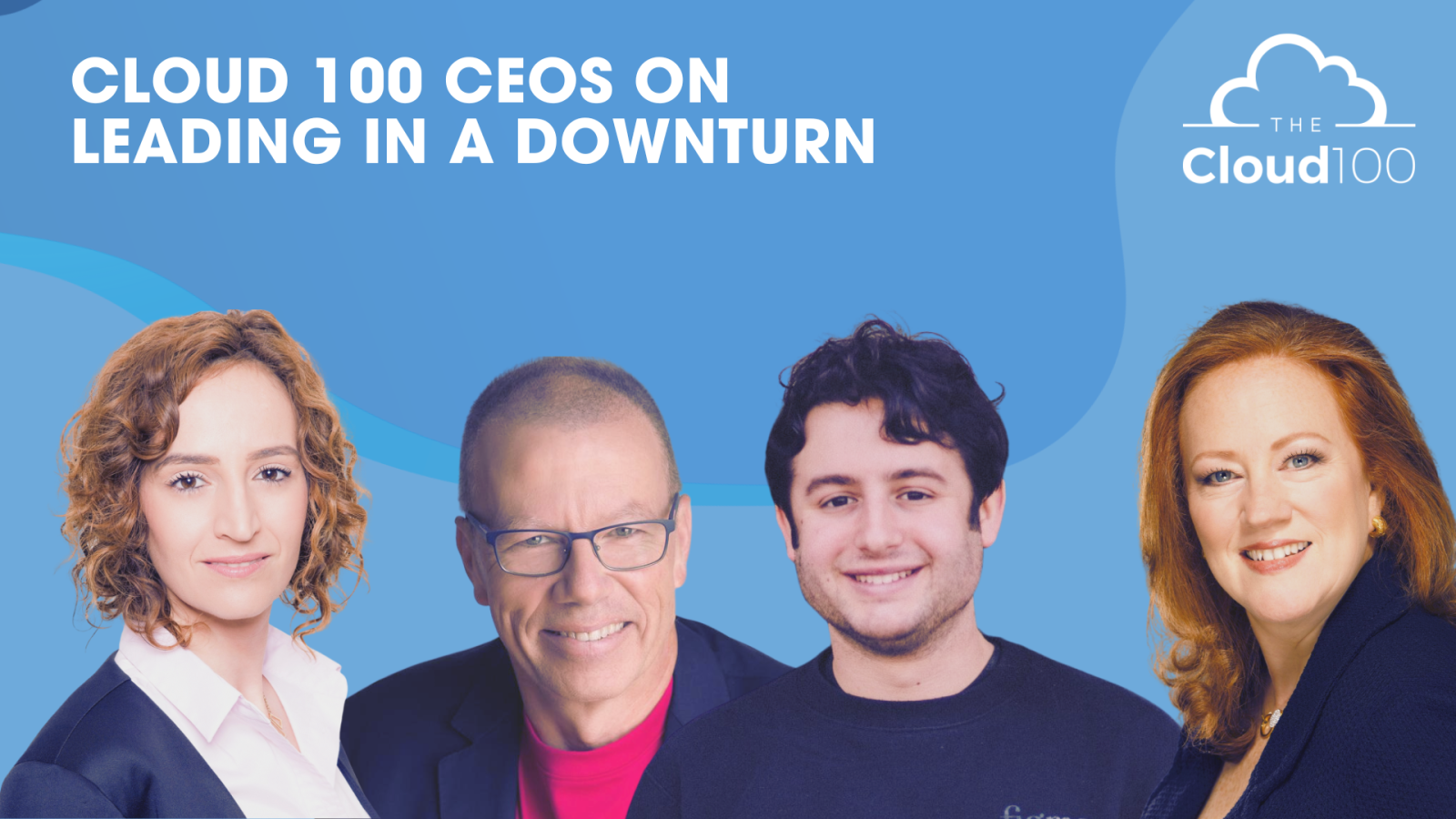With inflation on the rise, interest rates climbing, and geopolitical uncertainty, 2022 has witnessed a dramatic market correction that has impacted economies around the world, including tech.
However, while public markets have reacted to inflated valuations, the SaaS and cloud companies are still examples of businesses with great fundamentals and spending on digital transformation is on the rise. Top leaders in the cloud strive to build faster, serve their employees in new ways, and build efficient revenue models that can weather the downturn.
Today’s entrepreneurial conditions beg for not only practical advice for running successful upstarts, but also optimism to help CEOs and their teams reimagine how cloud can be a driver of innovation for the world during this time of transition.
We bring together four top cloud leaders — Dylan Field, CEO & Co-founder of Figma, Eynat Guez, Co-founder, CEO at Papaya Global, Bernadette Nixon, CEO and Board Member at Algolia, and Amit Bendov, CEO and Co-Founder at Gong.io. These Cloud 100 leaders share their stories from the trenches as they offer both strategic and tactical advice to founders on building enduring businesses. In this conversation, they’ll explore:
- Early stage obstacles and necessary pivots
- New perspectives on talent retention
- Go-to-market case studies to drive revenue
- How to make the right choices for the good of the business and its people
Hear more from them here:
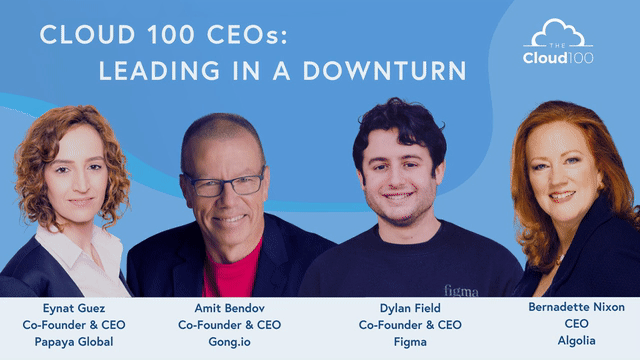
Transcript
Dylan: My name is Dylan Field, CEO, and Co-Founder of Figma.
Eynat: My name is Eynat Guez, CEO and Co-Founder, Papaya Global.
Amit: Hi, I’m Amit Bendov, CEO and Co-Founder of Gong.io.
Bernadette: Hi, I’m Bernadette Nixon, CEO of Algolia.
Bernadette: Hi, everyone. It’s great to be here today for Cloud 100 and for this conversation. If you look at 2022, it’s certainly been a crucible year for all cloud companies, and I also think for leaders and teams to showcase their potential and the vision of what lies ahead. That’s so crucial for teams in this climate. Why don’t we jump in with our first question? Certainly, we’ve all been SaaS leaders in bull markets and bear markets, but it is interesting to share how some of our priorities are shifting as we take a look at these headwinds. Maybe Eynat, could you start us off? How are things shifting for you guys?
Eynat: Yeah. 2022 is an interesting year, obviously, after quite a few years that each one of them has been interesting by herself. My three rules for these years are, first, be very pragmatic, and second, be very brave, because, at the end of the day, the decision that I take and each one of us are making our own decisions will impact our company. Be brave, be willing to stand behind them. The third is what I call “The trolley exercise.” We all start, we want to travel, and we all start with quite a lot of things that we want to package, but if we want to fit into a carry-on, we need to ensure that we can take everything that is essential and critical, and fit the luggage. It’s the same currently. It’s making, again, critical decisions, trying to invest in the future on one hand, but also reducing the cost of everything that is not super critical for the business.
Dylan: Yeah. Bernadette, there are early stage issues that we all face, and one of them is, certainly, category creation. It’s really convincing a market that they need the solution to the problem that you’re selling. I’m curious, for you looking back, what’s something that you feel you got right from the very start and, also, what’s something that you got completely wrong?
Bernadette: There are definitely examples in both categories.
Dylan: Probably for all of us, yeah.
Bernadette: Exactly. From our perspective at Algolia, from day one, we focused on being a horizontal API product and platform. In the early days, when Nicolas Dessaigne and Julian Lemoine, our two co-founders, were incubating the idea as part of the accelerator that they were part of, there were a lot of naysayers. People were giving them advice, “You need to pick a vertical.” And everybody was saying, “Go for e-commerce.” But they stuck to their guns. They stuck with building out a horizontal, API first, platform that was focused on delivering a great developer experience. It was a crucial decision for the company, and, what it enabled us to do, was to have a really crystal clear positioning as a developer platform, API first, and really Search as a Service. API and Search as a Service were both very well known and understood by the developer community and then became more broadly known and understood.
Bernadette: That’s one of the things that we believe we got really right from the beginning. The flip side of that coin is that we went upmarket, so a lot of companies that start with a product-led growth motion sometimes take a while to go upmarket and start a sales force. We went there pretty early, and that was really good for us, for the market that we are in. However, we forgot one thing we forgot that pricing was, actually, part of our product. And so we conflated this notion of pricing being part of our product and having to gate certain features that had applicability for all customers, but we put them and pigeonhole them in these enterprise plans to justify a price point. That did a couple of things. Number one, it slowed down our feedback loop from the market, and secondarily, it stifled our PLG, our product-led growth business, for a little while. We solved it, but it is definitely something we’d advise people not to do, based on our own experience.
Dylan: Yeah. The transition from bottoms up and product-led growth into sales is always… It can be very fraught, and a lot of companies have difficulty navigating those waters, so I don’t think you’re alone.
Bernadette: Yeah, I think you’re right.
Eynat: From my perspective, maybe, I’ll share our first few years because I came from a very bootstrap and operational background. When we started the company, we knew exactly what is the pain that we are solving, we were growing aside our customers from day one, but on the other hand, when we were speaking with investors, we had a really hard time convincing them that this is a real problem and a real need. The main thing is that they went and asked the CEOs of the company, “Do you have any issues with your global payroll?” And he said, “No, everything is great. I don’t have any issues at all.” They came back and said, “I don’t see the problem; everything is going very smoothly,” and I was constantly telling them, “You’re not asking the right person.”
Eynat: The people that are working behind the scene to make it happen, are the ones that you should ask. I think for us, the first three years were years of very rapid growth without getting, I would say, the market support from the investor side. But I think in reality, sometimes you are just coming from the industry, and you know things a bit before the investors understand the market or the problems. This is a piece of good advice for me, for everyone else that is an expert in this domain. If you feel that there is a real problem, if you’re coming from the field, don’t give up.
Amit: One thing that worked for us, we had very shell technology; we didn’t develop a lot of that technology, almost duct taped something that looked like a product. We almost faked it. It was working, but we gathered together whatever we can find on the internet, components that we could put together, and we charged early. Again, we didn’t need the money, we just wanted to know that we have something that people are willing to pay for. That was a good decision, in hindsight. Just duct tape something, don’t sweat the technology too much, see what people want, need, and are willing to pay for, and then you can build it.
Eynat: So Amit, a question to you. What are the lessons that you can share with early startup founders trying to currently start their own companies on the cloud side for them to be successful?
Amit: This would be my fourth downturn, 2000, 2008, 2020, and 2022. It’s helpful to think in terms of your mission for decades. This is a natural cycle that happens every now and then, every few years. Now it’s every two years, but it could be like every eight or ten years, and not worry about it too much. Of course, make sure that you have cash. Without cash, it’s a lot harder, but assume that you have that. Focus on the mission, the value to create for customers, and make sure that the value proposition is in line with what’s top of mind for people right now. It’s more, maybe, on efficiency and doing more with less versus growing some of the things that we’ve seen about a year ago. You worked on a product for two years just to launch a beta and a couple more years to start charging and selling, and you’re growing. Tell us about your thinking and your learning from that experience.
Dylan: Yeah. So many thoughts. By the way, I’ll start by saying there are lots of ways to start up, so I don’t think that there’s one right path. Tons of respect for what you’re doing and you; nothing here should be taken as a counterpoint to that. For us, we started in August 2012, and figured out what we were doing around June 2013. I launched our close beta in December 2015, and our J release in October 2016 didn’t make our first dollar until summer 2017. And so it was quite the journey. And I think I’d probably advise people not to do that and to make money faster and to get the thing out there faster. For us, it took a long time because we were building something with a big moat. It was something in technology that hadn’t been done before.
Dylan: And I’m excited and glad that we have that moat but in contrast, when we started working on FigJam, our second product, which we launched in April 2021. FigJam is a whiteboarding product for ideation brainstorming. And we were hearing a lot of need for that during the pandemic. And so it was something we talked a lot about with the team was “Hey, we got to get this out there before the pandemic ends because we need to help our users now.” And I think that urgency really translated into a fast development cycle that ended up being probably like eight months or so to build that in contrast to five years and then another year from there to monetize it. Or actually a little bit last like eight, nine months or so to monetize.
Dylan: And so I’m glad we’re moving faster now. And I try to instill that in the rest of the team, too, that perfect is the enemy of good and just getting it out there. The beautiful thing about software is that you can keep improving it. We’re not shipping couches or chairs, or you put it out there once, and then you’re stuck with it forever. And so I feel very lucky to work in bits.
Amit: Love that.
Dylan: On the topic of go-to-market engines and pricing. I’m curious if anyone has lessons selling into this increasingly hybrid world that we’re in now.
Eynat: I think for me, selling remotely in a hybrid world means two things. First, making things very, very easy. So try to create a very transparent, very easy pricing. I think that when you are overcomplicated at pricing, when it takes a lot of stages to get to a price proposal, you lose your audience. And also, eventually, it takes more time to go from just the prospect to the onboarding stage. But I think that the second thing which is much more important is that you have to ensure that you sell the product by the product. And I think I have two great examples here, Figma Gong, which we use internally in Papaya. And I think that if you have someone that loves the product when they see it, they are the buyer, they want to make it happen.
Eynat: They are your ambassador to assure that you are getting in… That you are going to all of the barriers, it can be legal, it can be pricing, and so on. So don’t sell over a presentation; sell over the product, assure that people can see the product and can touch the product. I mean, be proud of the product. I think for me if I go to a sales call and I see a presentation or PowerPoint, I mean the first reaction is stepping backwards because I lose the trust that I have. I want to see the product. I want to understand what is it for me.
Bernadette: Yeah. So I joined Algolia back in May 2020. So in the first wave of the pandemic, really. And so the beauty of an API first platform is it can solve many different search use cases, for example, for our customers. But I felt that we needed to get to repeatability one use case at a time. And that’s often a challenge that any platform out there will face. I know I’ve faced that challenge back going back to 2010, last 12 years only having experience with platforms. So we followed that philosophy, and obviously given the time with COVID and everything, it was a no-brainer to pick B2C eCommerce. So we instantiated that with the sales play, it became a cross-functional effort. It has to become a cross-functional effort in order to be successful. And it’s given us great results.
Bernadette: So now we keep going with that, and we’ve got a cadence every quarter. So it works really, really well for us. I’ve got a question for the group, every SaaS company, it’s in our DNA to be customer obsessed. I’d love to hear from some of you on how that manifests itself in your go-to-market strategies.
Dylan: I think it’s worth thinking outside of go to market as it’s traditionally defined for this one; for example, in the early days of Figma, I try to encourage our support team to think of themselves as marketing. I was like, “Hey if someone’s [inaudible 00:13:34] into you and they have like a very long ticket full of feedback, build a relationship.” Like you’re basically our evangelist right now. And a lot of those people who had all that feedback, later on, became evangelists. Of course, some of them became trolls as well. So ignoring the trolls there, but for the most part, it was very helpful. Just deeply engage with customers and really build up the community. And I think you can build a community in lots of ways, not just through good-to-market marketing.
Amit: Right. At Gong, we call it, we’re not saying we’re obsessed. We want raving fans. Right. And you said there, we don’t want happy customers. That’s the table stakes. We want like raving fans. And, and this is the marketing, right? They understand and no, not just doing it… But first, it’s fun, but we’re doing it actually because this is the marketing. We believe that mass marketing is like a customer spreading the gospel, right? We’re a new thing, a new category. The world doesn’t even know we exist. Doesn’t know why you need something like Gong. And we want it to rely on raving fans, which right away we extend both to employees. We want candidates which are our prospective employees, customers, and prospective customers. Everybody that has interaction with the customer. We want to rave about the company. And then when we succeed, that’s what we celebrate. And that is our best marketing.
Dylan: I will say for a product like growth companies and companies with self-serve, it’s so important to deeply understand all the mechanics of how it works and to also understand what metrics will affect other metrics down the road because it’s very possible to miss over here. And then three months later, you’re missing over here, and it’s actually just one miss. And so really being hardcore about that and tracking everything and then being super diligent with your team, if you have a miss, I think is super important.
Eynat: Yeah. So I’d like to ask the group as a CEO of a global HR and payroll platform. I can’t help myself and ask you and wonder what is for your… In your perspective, the best place to work means currently in these days; what makes it a great company for employees to work? What benefits matter? I’ll be very happy to hear your perspective.
Dylan: I think especially on a call like this, where we’re across the world and in very different areas of technology, I think it’s important to note that there is such a thing as culture market fit. In terms of company culture and how that matches the market you’re serving. I don’t think that there’s one answer to this question. And I think for Figma, for example, some of the things we think a lot about are how do you create a playful spirit when you come to work? How do you have fun and make it a really enjoyable experience to be here so we can all be creative together? And so we do things like make your weeks where we have the entire company gather and come together for a week to really be innovative. Other companies probably would not really have that same reaction to those things. Or they might be annoyed if that was the approach and culture that they experienced. And so I think there are lots of different ways to work together as a company. And again, not just one way to start up.
Amit: Right. I think it’s like, it’s easy to stay. It’s not always easy to practice, but what you try first, people want like a sense of purpose, right? That they believe in what the company does. They have room for growth, they’re trusted, and they have the freedom to operate. They have the right environment and setup, and they can shine and blossom. And work feels more like joy than a chore. Now you got to make sure that you have the right team in place, the right infrastructure, and really a good cause that everybody rallies around, but it boils down to this like purpose empowerment and self-fulfillment.
Bernadette: I often think in pictures. So I have a triangle in my head right now. So the three layers. And I look at the bottom layer as the table stakes. Yes, that’s comp and benefits and rewards, but that’s not what… It’s just what it says. It’s table stakes. It’s not what you’re going to differentiate on. You differentiate on, in my opinion, your employee value proposition, which is some of the things like Amit was saying, it’s your values. It’s really your contract with not physical, legal contracts, it’s your commitment to your employees as to what your environment and their environment is going to be like to work in, whether it’s physical or virtual or hybrid or, or whatever. But it’s governed a lot by your values. Care and humility and trust and things like that are specific to each of us.
Bernadette: And then on top going to the purpose element, that’s unique, and it’s… We actually simplify it because I could never get my head around vision, mission, and purpose. It was all too much. So we said, it’s the one thing for all of us our goal, for example, is powering discovery, our vision, our mission, we’re doing it today. There’s so much more that we want to do. And yes, it is our reason for being. So that’s how I think of it table stakes, but then differentiate on the employee value proposition and your vision, and people can buy into it and relate to it and join or choose not to. And that’s okay.
Eynat: I heard something nice recently that actually a successful company, you take this triangle, and it should be upside down because leadership should be on the bottom of it. And if you’re building the company successfully. So actually, I mean the leadership is just the point that holds it, but the whole other team is the one that really creates the value and can grow and blossom, as Amit said. So yeah, I really agree with that.
Dylan: Eynat, I know that you’re really passionate about social impact and just generally doing good in the world. And I’d love to hear more about what informed those viewpoints, how they manifest for your company, and also what you think the role of capitalism is. And should every company be participating in this social impact, and what are the bounds of that?
Eynat: Yeah. So it’s really one of the topics that I’m really passionate about because I think that as CEOs, as founders of companies, we have a rare opportunity not only to create great businesses but also to leave a mark in the world. And I also always want to be in a place where I can come home at the end of the day and tell my kids that I contribute a bit to a better world for them. And for us in Papaya, it’s really seeing how we bring more and more people from different backgrounds from different places to be part of this journey.
Bernadette: Yeah, it’s interesting. I think when you look at some of your core values guides how you look at these things. Care is one of our core values, and we support many different and diverse, both social and humanitarian causes. And we do that employee-driven through a matching program, charitable matching program, which is good. But I think now we’re being more intentional about how we go about leaving a mark, a positive mark on the world. And so we’re taking what we’ve focused on historically around a carbon offset program that was very loosely administered. And really now I’ll be doubling down, I should say, on becoming net zero; we’re exploring the idea of becoming net zero by 2030 and doing it in such a way that it’s provable, it’s permanent, and you can validate it.
Amit: I’m grateful that we have inspirational leaders, like CEOs, like Bernadette and Eynat that inspire a new generation. They can see themselves and also with the underrepresented minorities. So we’re pretty active and in dozens of ways. And I think that every company that does, that makes this world like slightly better and if we all do it’ll, it’ll be a lot better.
Dylan: The other thing that we started to do that I’m excited about is more unique to Figma is Figma and Chromebook. We just did a partnership with Chromebook where I need a school district in the United States. And hopefully even broader in that later on, can just press a button and then deploy Figma to all the Chromebooks in their district and really excited to see how this impacts high schoolers and kids that are, are on the younger side as they go and grow into their careers. I certainly didn’t know that design was a viable career option when I was in high school or middle school. I hope that the next generation can actually see that as a great path forward. Especially as we have so few designers in the world and is such a huge demand, I think, across all of our companies to find and attract more designers right now.
Eynat: So question to the group, there is an all cliche that best tech companies has started in days like this over the downturn of the markets. So if you currently need to give your best advice to early startup founders about where they need to put their best efforts, what are the areas they need to double down? What would it be?
Dylan: I think it’s a lot of the same lessons that we’ve had in the past with the addition of be really consider your cash. Don’t assume that if you raise, you’re going to be able to raise again. And I think by being conservative like that, you’ll build an efficient and focused business. That’s very on mission and targeted. And that’s, I think, a really good predictor of success later on as well as you scale your business and grow. So if you’re listening in your early stage, best of luck; we’re all ready for you.
Amit: Right. I agree. You need to watch the cash, but hopefully, you have enough. Customers have needs; everybody of needs, right? They’re different. Find them, and you can succeed in a big way.
Bernadette: You hear a lot of talk at the moment as well with regards to, you’ve got to ruthlessly prioritize. That’s the name of the game. It’s not as easy as it sounds. It’s easy to say it. It’s not quite as easy to do it. And so what’s interesting is I think that the flaw in that notion of ruthlessly prioritizing is that’s a very one-dimensional people typically think of that in terms of a list, doesn’t give you a lot of options to think in a multidimensional way. So I think you need at least two Xes what’s the effort it’s going to take and what’s the impact it’s going to have and plot and figure out which ones you’re not even going to bother with right now. So I think there’s a lot of lip service to ruthless prioritization.
Bernadette: I think we need to talk about the fact that it’s not that easy in reality when you get a group of people because of the competing vantage points that they may have. So I think having a framework that helps you with that is a step in the right direction. And I think that’s going to be really important moving forward.
Eynat: I would just add to this that I think I would double down in everything that beat the metrics. So take the metrics and understand how do you beat them and double down there. So it can be the cost of customer acquisition that should be super efficient. It can be even eventually the ARR. It can be any metrics that matters in the business, but assure that you have all of the efforts and that you can double down and eventually be the best in class.
Dylan: Thanks all for this awesome conversation. Really good to see y’all congrats on getting on the Cloud 100.
Amit: Great seeing everyone and looking forward to next time.
Eynat: Thanks, everyone. It’s been a pleasure to meet you all. Congrats on Cloud 100, and looking forward to meeting you again.
Bernadette: I loved the conversation today. Thanks very much, indeed. And congrats on Cloud 100 again.
